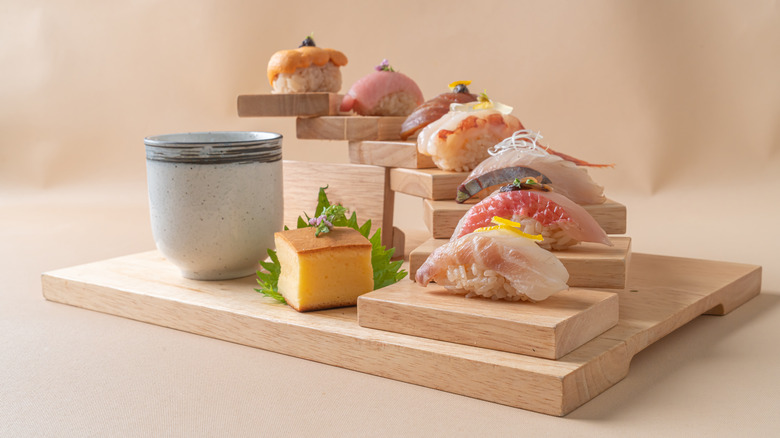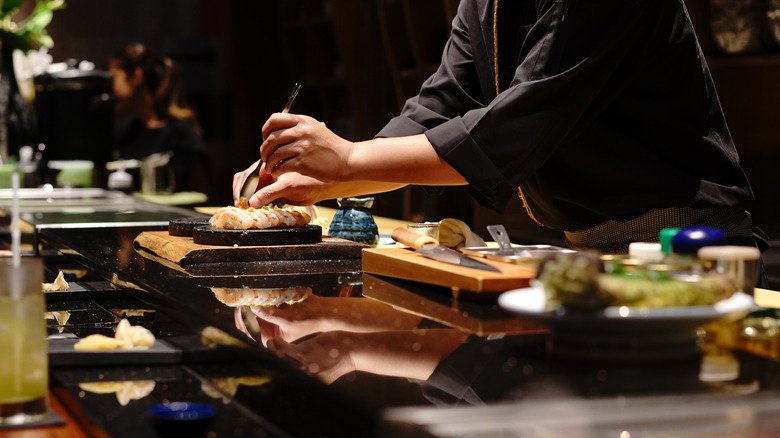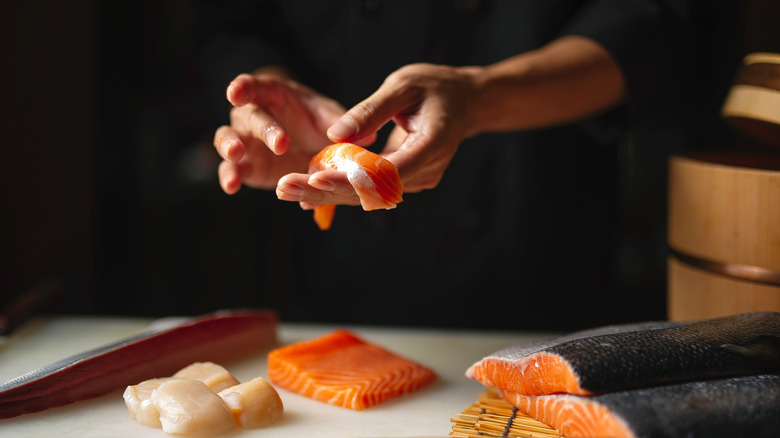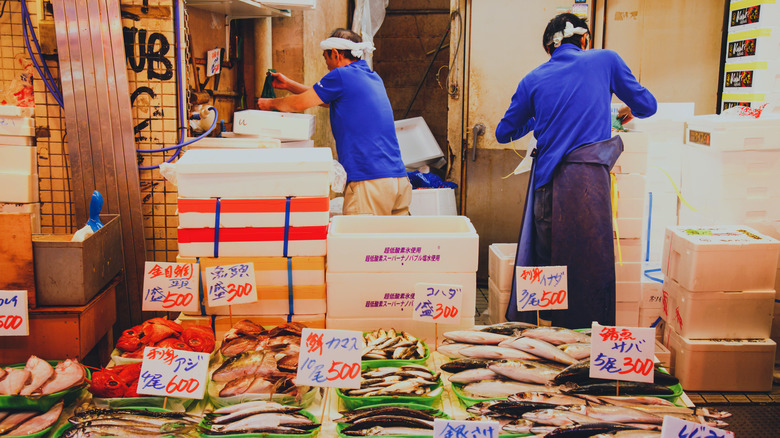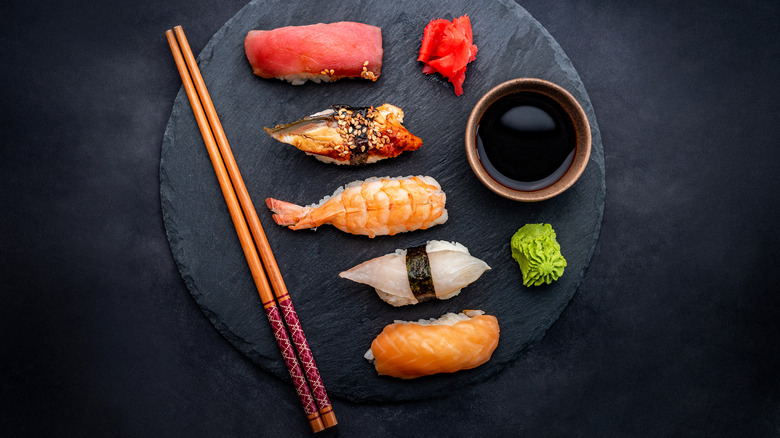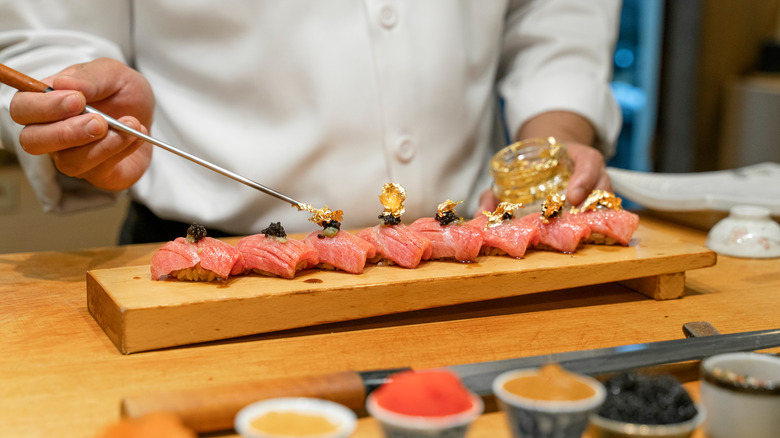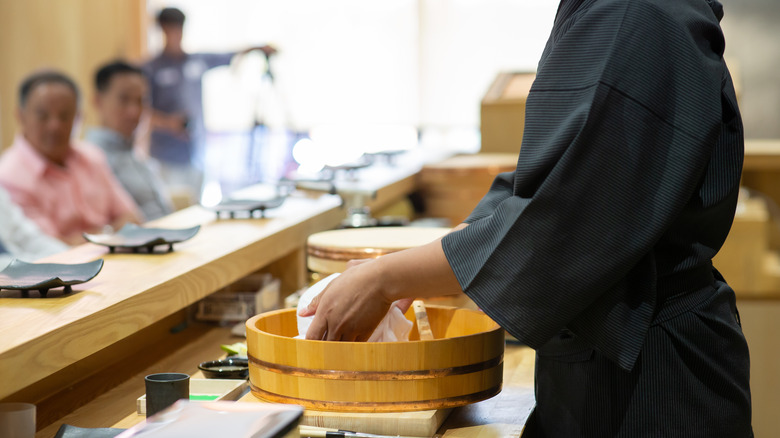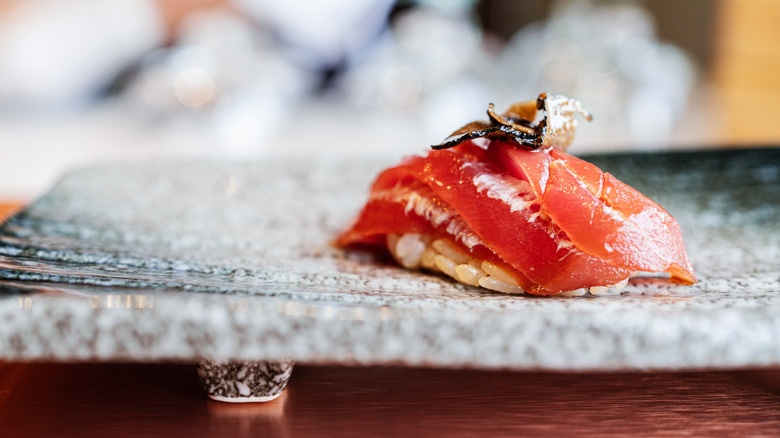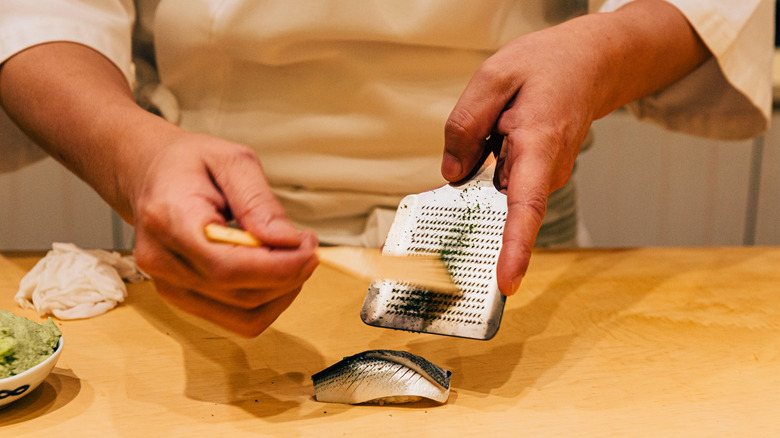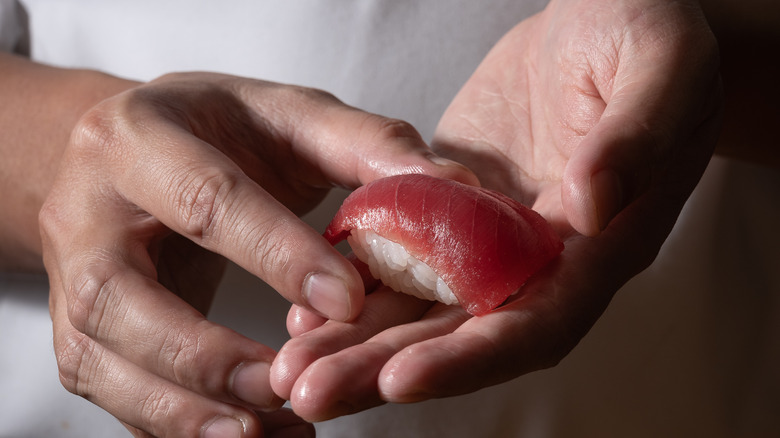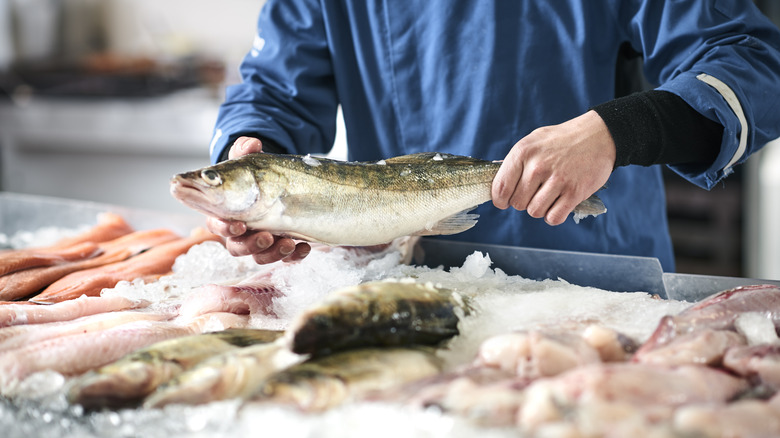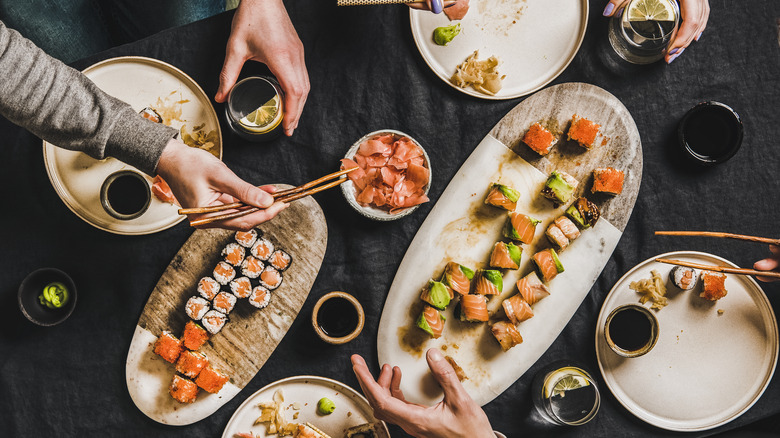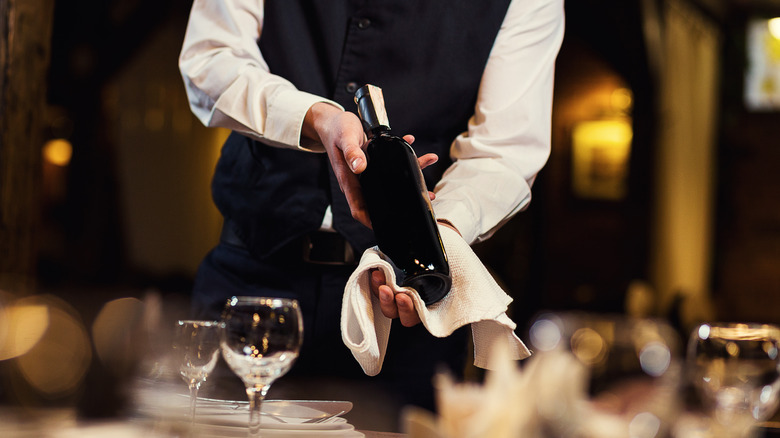Everything You Need To Know About Omakase
Going out for sushi is always an enticing experience for any seafood lover. The delicate balance of perfectly seasoned rice with assorted toppings can be as much of a visual experience as one for your taste buds. Conversely, it also might entail bold flavors, cream cheese, and deep-fried rolls, if that's your style. Regardless, you typically have to make a number of decisions when you order sushi, which isn't always an easy feat! Then, perhaps once you've made your selection, the waiter informs you that, unfortunately, they've run out of one of the prime ingredients in your favorite roll.
Omakase dining eliminates all of these issues. Although it can be used in dozens of contexts (which we'll explore further along), among them, omakase sushi has become fairly widespread in the US. Essentially, it's the ultimate version of the chef's choice, and your dining experience is left to the experts. While it's perfect for the adventurous, if you're not so willing to renounce all responsibility, certain formats allow diners to have some input. And sure, a limitless budget might be the best way to enjoy an omakase dinner, but it isn't necessary if you know where to go. We've got the inside scoop so you can relax and let the sushi masters do their thing.
You'll be leaving yourself in the chef's hands
If you've ever asked a waiter or friend to pick something from the menu for you, then you've sort of engaged in omakase-style dining. According to the Michelin Guide, the direct translation means "I leave it up to you" — you being the chef. While it certainly isn't suited for all eaters, allowing yourself to be surprised by a steady influx of creative dishes becomes more than just going out for a meal. As per SushiFAQ, customers definitely have to entrust themselves to the chef; but when they do, the experience can be described as a gastronomical theater.
All the same, the best kind of omakase chefs will involve the diner in the experience, carefully observing them in order to serve the ideal succession of rolls. Ultimately, it becomes a conversation (often without words) between the diner and chef, giving the chef free rein to explore their inspirations in real-time. Chef-owner Nobu Yamakazi explains to the Michelin Guide that based on how the customer is reacting to each piece of sushi, the meal can vary significantly: "Sometimes we might just completely change it in the middle of the course." Be ready to expand your palate, and don't hesitate to express which dishes are working for you and what you're less fond of. An attentive chef will pivot at any point to satisfy their diner.
Every chef has their own unique omakase style
Since the chef is in charge, it's worth mentioning that every cook has their own philosophy in the kitchen. Also, whether you're sitting at the bar facing the chef or at a distance in a dining room will largely dictate how the meal goes down, and affect the level of attention that the chef can provide. Whereas the pinnacle of omakase dining occurs when the chef is creating every dish as a response to each individual customer, a more straightforward experience consists of a set menu with possible extras (via Michelin Guide). Especially in a larger establishment, the latter style is more feasible to accommodate more guests.
The Manual explores nuances in technique with two omakase chefs, highlighting some variations. To the untrained eye, a sushi roll might not appear to leave much room for experimentation, but a lot of detail goes into ensuring that every bite is perfectly balanced. Chefs not only seek equilibrium in each piece but also in the progression of the meal. Chef Jay Zheng explains that light fish is favored at the start, slowly followed by fattier richer fish as the palate awakens, though the specific selection is personal (via The Manual). Apart from the typical nigiri offerings, chef Tomoyuki Hayashi likes to serve small bites like hand rolls and tamago (Japanese omelet). As for the nigiri, each chef highlights the fish's fresh flavors with subtle hints of seasoning as they see fit.
Fresh seasonal ingredients will dictate the menu
Chefs prioritize seafood that is in season in order to deliver a meal of exceptional freshness and quality. There's no need to use ingredients that aren't at their peak since the menu is fluid and can easily be adapted to showcase the best products. In some of America's top dining destinations (namely LA and NYC), omakase chefs go to great lengths to obtain seafood from Tokyo's revered Tsukiji fish market. Chef Masa Takayama has a handful of prestigious restaurants in NYC and LA, and he explains to Vogue that he faxes his orders to agents who coordinate the shipment from the market until he picks it up at the airport. For chefs who spent years working in Japan, nothing else stands up to the quality available at Tsukiji.
Of course, sourcing local fish is equally important, and KCRW speaks with chef Hiro Naruke who describes the near-daily task of visiting the fish market in LA in the wee hours of the morning. The selection is unlike anything you'd ever see in a supermarket (which might make the price of an omakase slightly more palatable), with a diversity of seafood from the entire world. You won't only find wonders from the sea, and Naruke also buys fresh wasabi root from the LA market. It turns out, the wasabi you've been eating from casual sushi eateries isn't the real deal, which is far rarer and mainly grows in Japan, according to Britannica.
You won't necessarily spend a fortune
Fresh seafood shipped in from Japan doesn't come cheap, but thankfully omakase is available to a range of budgets. Your best bet for an affordable omakase is choosing a restaurant that serves a fixed price menu, which often includes optional add ons if you want to make a few splurges. Although it isn't as exciting as an unpredictable experience that could change on a whim, you won't end up with an unexpectedly extravagant bill. Keep in mind that sushi is pricier than other dining options, so you're probably not going to find a decent $20 omakase.
Nonetheless, some chefs have found ways to serve a delicious omakase while catering to a wider audience. Take Kintsugi in NYC, which has four categories for every budget, starting with "The Rush Hour" at $65 for nine pieces of nigiri and one handroll. Meanwhile, Sushi on Jones offers a 12 piece omakase for $58 at various NYC locations. In LA (with a few locations in NYC), Sugarfish has options for people eager to be surprised ("Don't Think. Just Eat. Trust Me,") and those who want to know what's being served ("Trust Me" or "Trust Me Lite"). From $22 to $55, this is definitely a wallet-friendly place to enjoy excellent sushi. On the east coast, you'll find Izakaya Minato in Portland, Maine serving up a friendly family-style omakase for $40 a head.
It can quickly get very expensive
A bit of research can reward you with an affordable omakase menu, however, it's typically an occasion that welcomes splurging. Take Masa in NYC, regularly labeled as the most expensive sushi restaurant in the country according to Food & Wine. The basic omakase menu will cost you $650, and if you want the Hinoki Counter Experience you're looking at $800 before tax and drinks. Nevertheless, if you want to try arguably the best sushi in the US and savor an evening unlike any other, Masa's your spot. At least at Masa the cost of the omakase is clear; this isn't always the case.
A writer for Vice shares a dining tale the average person would have a hard time swallowing. After enjoying what two friends thought was a lavish yet affordable dining experience, they received a bill for $1100. The main culprit? The remarkably fresh and creamy sea urchin at around $100 per piece. If you want to avoid that kind of surprise (on your plate it's fine — less so on your bill), Vogue writer Jeffrey Steingarten suggests calling ahead of time to arrange a fixed price for your meal to ensure the bill doesn't get wildly out of control. If you have the means to enjoy an omakase sushi dinner, then indulge with the knowledge that you'll be getting a high-quality one-of-a-kind experience that goes beyond gastronomy.
The experience is usually intimate
While there are different styles of omakase with various levels of customization, at the top of the rank is the counter experience. Diners sit along a small counter as the chef prepares each piece of sushi one by one, handing them over as they are ready. Typically, only a handful of people are seated at a time so that the chef can attend to each with care. For this reason, Sushi Modern explains that omakase goes beyond a simple tasting menu. With every bite you take, the chef observes your reaction to dictate their next move.
To fully enjoy an omakase, you should be willing to reciprocate the attention by sharing your thoughts about the assorted dishes. Chef-owner Yamazaki says that the most important factor is whether the diner is enjoying the food (via Michelin Guide). So while you might not want to spit something out in disgust, take advantage of the personal nature of the meal by showing extra enthusiasm for the nigiri you're loving. In turn, the chef will be able to concoct a menu specific to your taste.
You will taste familiar and totally new items
More flexibility for the chef also means that you'll probably end up trying some unique items you've never tasted before. Chef Sekiguchi encourages diners to keep an open mind when they are coming for omakase sushi (via Michelin Guide). Allergies aside, discovering new flavors and unexpected combinations is essential to the magic of the experience. If you really only want to eat a select few items, then your time and money will be better spent simply ordering from an à la carte menu.
Not only do you get to try a range of exciting dishes, but you don't have to make a tedious attempt to understand confusing sushi terms to make your order. SushiFAQ recommends omakase for sushi lovers eager to broaden their palate, or conversely, to a complete sushi newbie who wants to dive in headfirst. Whether you're tasting a certain fish for the first time or it's a regular in your sushi rotation, enjoying it at its peak freshness can be significantly different. According to The Manual, in cooler seasons, fish retain fat which results in more flavor and a richer texture. Unless you're the kind of diner who needs to be in full control of your meal, everyone can find something new to savor in an omakase service.
You might not have free rein over the soy sauce and garnishes
If you're accustomed to loading up on wasabi and pickled ginger and dipping your sushi in soy sauce, leave that all aside and follow the chef's lead. Omakase is all about crafting the ideal balance of flavors, and chefs spend a lot of time perfecting this harmony. For example, chef Hayashi notes that he takes great care to season nigiri with citrus, salt, and subtle flavors to avoid masking the fish (via The Manual). He adds that soy sauce can overpower lighter fish, and sticking to the same seasoning over and over quickly becomes boring for diners.
Your best bet is to eat each piece as it is presented to you. If soy sauce or other garnishes are available, feel free to ask the chef if a certain roll should be dipped. That way you'll avoid offending them and you'll be able to enjoy the meal exactly as the chef intended. Remember, the whole point is to entrust yourself to the expert! Anyway, just about every other sushi meal you'll have will involve all the typical extras, so if you're obsessed with wasabi, you won't miss out forever.
Eating with your hands is encouraged
You might be proud of your chopstick handling skills, but it turns out that they aren't considered to be ideal for picking up sushi — except if you're dealing with sashimi (thin slices of raw fish), Condé Nast Traveler explains. The best way to truly savor each piece is with your hands, chef Nobuyuki Matsuhisa tells the Daily Mail. Of course, your hands had better be extra clean, but as Matsuhisa reasons, "Sushi chefs make it with their fingers, so you should eat it with your fingers. It's the best way."
Meanwhile, chef Zheng remarks that when you eat with your hands, the temperature of the rolls becomes similar to your body's, creating an ideal match (via The Manual). Chef Hayashi also points out that to produce the perfect balance of texture with the fish, he makes his rice fluffier, which is easier to hold with your fingers. If he notices a diner using chopsticks, he adjusts his technique: "I make the nigiri rice tighter, so it's easier for them to eat." Unless you want to get your hands all sticky, here's one more reason why you don't want to start dipping your sushi in plenty of soy sauce!
It might not be the most sustainable dining choice
Indulging in an omakase dinner might feel like the ultimate way to treat yourself, but it's undeniably not so favorable for the environment. For starters, importing fish from Japan via airplane isn't going to win any eco-conscious points. More importantly, the fish in question is the larger issue at hand. And while there are areas of the world with strict restrictions dictating fishing, other regions are less worried about their impact and more interested in supplying the demand (via Vogue). The World Wildlife Fund lists overfishing as a key problem, explaining that it can lead to the extinction of certain species, most notably bluefin tuna.
Ideally, if you're eating in a reputable establishment, they will have done the legwork of sourcing fish obtained with the highest standards of quality. Organizations such as Seafood Watch have an app to educate consumers about a wide range of items, allowing you to make an informed decision about your sushi. Fish aside, other ingredients such as avocados, rice, and seaweed can also place an unnecessary strain on the environment when the demand exceeds natural production (via WWF). Ultimately, unless you're a full-blown locavore, food production entails many questionable practices. Do your part by selecting a sushi restaurant that sources its fish responsibly, and perhaps stick to enjoying the full spread on special occasions.
Omakase sushi is a relatively new concept
It might seem like such a deliberate style of dining has been around forever, but the notion of omakase sushi is fairly novel. Live in Japan indicates that as sushi began to reach a wider range of people in the '90s, omakase followed as an easy way to enjoy an assortment of rolls and dishes without having to understand all of the specific terminologies. The outlet adds that this style of dining allows people to save face when they don't know certain fish and ingredients — an important tenet of Japanese culture.
Michelin Guide compares omakase with kaiseki, a multi-course Japanese meal with a set order, whereas the former is constantly changing. Apart from catering to guests, chefs can expand their creativity and work with what they have instead of promising the same sequence of dishes to all diners. For passionate chefs, this is the true essence of cooking. Whether you're in Japan or the US, walking into a sushi bar and requesting omakase is the best way to enjoy the variety and wonder of sushi.
In Japan, ordering omakase-style is also common in other contexts
While the most widespread understanding of omakase refers to sushi, Live Japan explains that the concept of leaving it up to the person in charge is used in other contexts, too. For example, many restaurants will provide an omakase lunch service. Customers can rest assured that they'll be fed, yet they don't have to make any choices from the menu.
As well, allowing a sommelier to select your wine is another form of omakase. And let's face it — unless you have extensive wine knowledge, they'll probably have a better idea of which bottle works best with your food. Live Japan points to cocktail bars as another location where omakase may be your best bet. Sure, there's often a menu, but as long as the bartender doesn't appear overloaded with orders, asking for something that's sweet, sour, or bitter, or specifying one spirit and leaving the rest up to them is a great way to experiment.
Outside the realm of food and drinks, fashion omakase is an increasingly popular trend in Japan, per Live Japan. Companies like ZOZOTOWN provide personalized shopping experiences based on survey questions. Not sure what haircut you want? Let the hairdresser decide. Can't quite choose your next holiday destination? Show up at the airport and find out! While certain aspects of your life are best left in your control, choosing omakase in others is a fun way to instill a bit of adventure.
